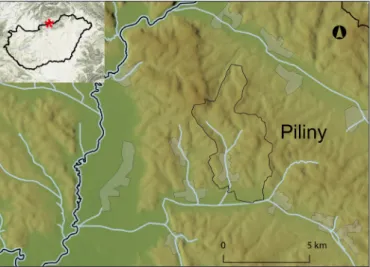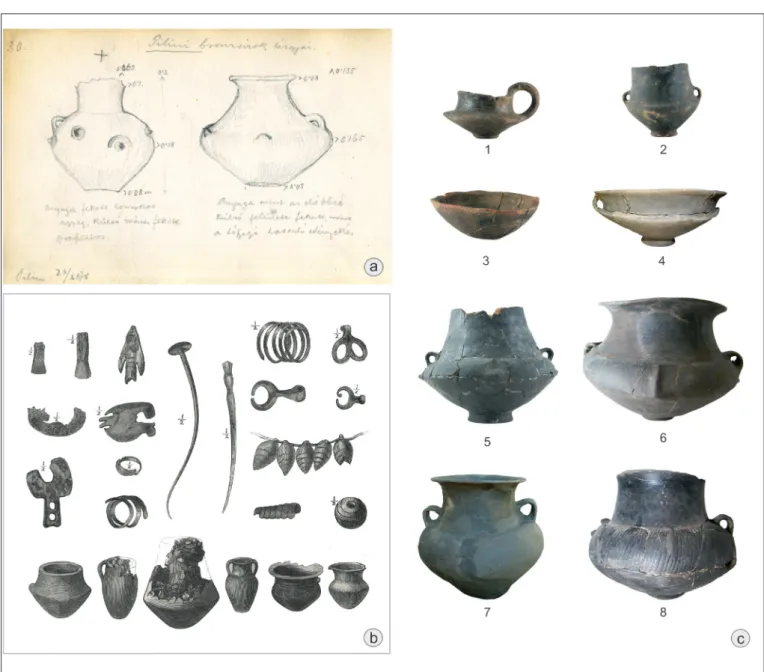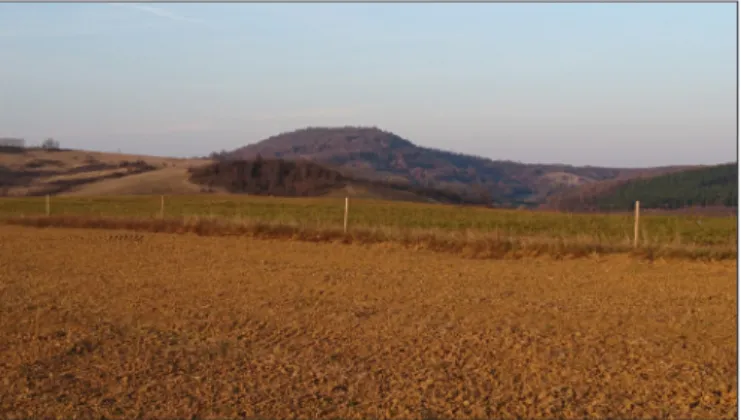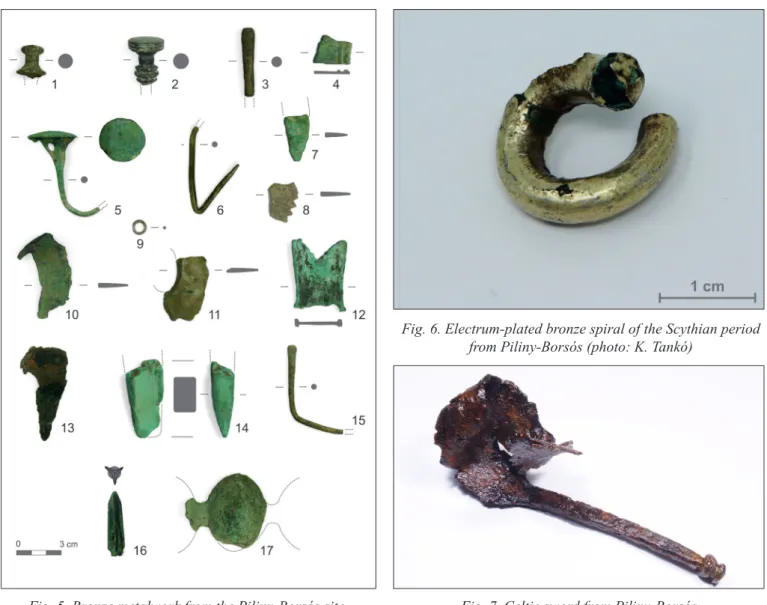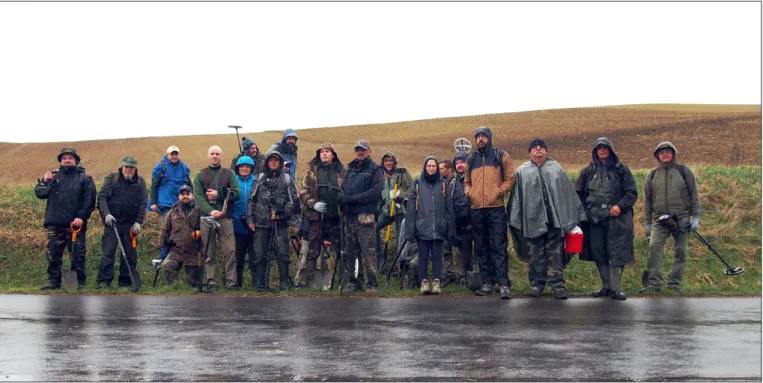“FOLLOWING THE TRAIL OF THE NYÁRY BARONS”
Investigation of the Eponymous Site of the Late Bronze Age Piliny Culture and one of the most important sites of Scythians in Hungary
Szilvia Guba1 – Károly TanKó2
Hungarian Archaeology Vol. 9 (2020), Issue 2, pp. 21–28. doi: https://doi.org/10.36338/ha.2020.2.4
Piliny is a small village with a few hundred inhab- itants in the picturesque Görbe Land in County Nógrád. Yet, it is also an important location in the cradle of Hungarian archaeology, where members of the Nyáry family, driven by their interest in, and commitment to, Hungarian archaeological schol- arship, conducted memorable investigations on the land they owned. Their untiring collecting activity and their persistence in assessing the finds was a continuation of the work of Ferenc Kubinyi, their predecessor, to whom they were also related by blood. They contributed much to the archaeologi- cal investigation of the settlement and to the better understanding of its prehistory, which commanded considerable attention in the international archaeo- logical community. The present study offers an over-
view of our research project funded by the National Cultural Fund, whose goal was to identify the locations of the excavations conducted by Baron Jenő Nyáry and his brother and son, both called Albert.
Piliny is a village in County Nógrád, in north-eastern Hungary, where the north-south valley of the Nagypa- tak Stream joins the east-west valley of the Ménes Stream, part of the catchment of the River Ipoly (Fig. 1).
The excellent geographic and environmental conditions undoubtedly played a major role in that the area became one of the regions of the Carpathian Basin that is extraordinarily rich in archaeological relics.
“THE MATERIAL AMASSED WITH SUCH […] CIRCUMSPECTION WILL SOON IMMORTALISE PILIN AS ONE OF THE MOST EXTRAORDINARY NAMES OF OUR HOMELAND”
The area’s archaeological exploration began in the later nineteenth century when Jenő Nyáry and his brother Albert began collecting various finds in the area and from the locals. The discovery and recovery of the finds was greatly aided by the use of steam ploughs on the estates owned by the Nyáry family, which enabled drawing formerly unploughed land into cultivation. Excavations were undertaken on several hills that seemed promising: Sirmány, Leshegy, Várhegy and Borsós Hills (Fig. 2) (Nyáry J. 1869, 266–267;
1870, 125–129; 1873, 16–23; Nyáry A. 1902, 210–241; 1904, 50–70). Jenő Nyáry uncovered some two hundred prehistoric graves on the latter and published a report about the bronze and, to a lesser extent, iron metalwork that came to light in the first issues of Archaeologiai Értesítő (Nyáry 1869, 266–267; 1870, 125–129). The published finds included clay stamps, gold and electrum coils terminating in animal heads and a bronze handle modelled in the shape of an animal. The report also mentions a settlement feature con- taining “kitchen refuse”, which yielded clay animal figurines (Nyáry 1870, 125–129).
1 Kubinyi Ferenc Museum, Szécsény. E-mail: gubaszilvi@gmail.com
2 MTA-ELTE Research Group for Interdisciplinary Archaeology, Budapest. E-mail: tanko.karoly@btk.elte.hu
Fig. 1. Administrative area and geomorphologic environment of Piliny (drawing: Sz. Guba)
These magnificent finds, unparalleled at the time, were displayed at the international archaeologi- cal congress held in Budapest in 1876, which pro- vided an excellent occasion for the site and its finds to become known to a truly broad archaeological community (Hampel 1876, 70–81, 107–116; Ham-
pel 1886, Taf. 70, 1–10; 71, 2–12). This is the main reason that the site became the eponymous site of the Piliny culture, the region’s major Late Bronze Age culture – even if this occurred a few decades later (eisNer 1933, 91). The Early Iron Age graves uncovered on Borsós Hill provided a sound basis for the identification of the Scythian finds of the Carpathian Basin (rómer 1878, 183; Hampel 1893, 385–407; reiNecke 1897, 1–27). The iron artefacts
Fig. 3. (a) Description and sketch of the vessels from the Piliny burials made by Elek Csetneki Jelenik in 1878; (b) finds from Piliny published by János Érdy Lutzenbacher in 1871; (c) the distinctive vessel types of the Piliny culture (photo: Sz. Guba)
Fig. 2. Archaeological sites in the Piliny area: Leshegy Hill in the foreground with Borsós and Sirmány Hills behind it and Várhegy Hill rising in the background
(photo: K. Tankó)
discovered on the outskirts of Szob and Szendrő, and the iron weapons brought to light on Borsós Hill pro- vided the first archaeological evidence for the presence of the Celts in Hungary during the Late Iron Age (pulszky 1879; TaNkó 2019, 159–161). Thus, the rich corpus of finds from Piliny has been known to Hun- garian and international archaeological scholarship for 150 years: while their significance is undeniable, the exact findspots have been forgotten with the passing of time.
VÁRHEGY: WHERE THE PILINY CULTURE IS NOT ENCOUNTERED When searching for the locations where members
of the Nyáry family conducted their archaeolog- ical research, we first targeted the Várhegy rising on the village’s outskirts because according to Jenő Nyáry’s notes, the urn cemetery lay beside the “pre- historic settlement”. The Várhegy was first exca- vated by Albert Nyáry, in the course of which he identified a circuit made up of a double ditch and rampart around the plateau (Nyáry 1909, 415). The site is now registered as a hillfort owing to its ditch and rampart circuit and artificial terraces. The pla- teau-like summit lying at an altitude of 386 m a.s.l.
(Fig. 4) was erroneously designated as a fortified
settlement of the Piliny culture, which took root in Late Bronze Age studies (kemeNczei 1967, 233; Fur-
máNek 1977, 260), despite the fact that only Copper Age and Early and Middle Bronze Age settlement finds have been identified on this site to date (kalicz 1968; paTay 1995; paTay 1999).
The summit is currently covered with a dense thicket, enabling but limited surface observations, col- lection of finds and metal detecting surveys. The ramparts were levelled in the course of vine cultivation in the nineteenth century and quarrying during the twentieth century, and even expert eyes were unable to identify their traces (Nováki et al. 2017). Our original goal, the identification of the one-time fortifications on the Várhegy thus proved impossible and the geodesic survey was limited to determining the edges of the plateau. It is our hope that other archaeological diagnostics procedures (principally LiDAR surveys) will provide information on the one-time ditches. The assessment of the pottery collected on the site confirms earlier observations that the site was occupied during the Late Copper Age (Baden culture) and the Early and Middle Bronze Age (Hatvan culture). The metal detecting survey yielded virtually no finds: no more than two slender bronze awls dating from the Late Copper Age and Early/ Middle Bronze Age came to light (BoNdár 2019). This can in part be explained by illicit metal detecting activity and in part by the scarce use of metals during these two occupation periods.
BORSÓS HILL: WHERE THE PILINY CULTURE IS ENCOUNTERED
One major undertaking as part of the research project was the identification of the archaeological site of Borsós Hill and the collection of diagnostic find material. The site’s exact location faded into oblivion dur- ing the over 150 years that have elapsed since its discovery and repeated efforts to identify the site proved unsuccessful. This was surprising, given that the surviving reports and the finds all suggested that it was a fairly extensive and intensely occupied settlement. We conducted systematic field surveys in order to locate the site, using the field methods employed during the ISzAP project (FáBiáN et al. 2016, 1–10). Addition- ally, we applied archaeological site diagnostic methods such as metal detecting (cf. V. szaBó 2010, 22–23), site survey and artefact collection using the site scanning method as well as aerial photography with drones.
We conducted several field surveys between 2018 and 2020, in the course of which we surveyed a roughly 40 hectares large area, partly in the Nagypatak valley and the ploughed fields flanking the stream, and partly in the area bounded by Borsós Hill and Leshegy Hill. The latter involved the systematic survey
Fig. 4. View of Piliny-Várhegy from Leshegy Hill (photo: K. Tankó)
of a 23 hectares large area, where we successfully identified the Late Bronze Age site. We located the site of the urn cemetery by recording the co-ordinates of the calcined human bone splinters and pottery fragments as well as the stones of various sizes indicating the one-time stone packing over the burials. Simultaneously with the field survey, we also conducted a metal detecting survey, as a result of which we brought to light several bronze jewellery items such as pins and bracelets, tools and implements such as broken sickles and razors, and lumps of molten bronze (Fig. 5). One remarkable find was an electrum lock-ring of the Scythian period (Fig. 6), several trilateral bronze arrowheads (Fig. 5. 16), the fragment of a hollow-knobbed Celtic anklet (Fig. 5. 17), an iron sword (Fig. 7) and a spearhead (GuBa & TaNkó 2019, 180–182, Abb. 8). In sum, the scatter of calcined human bones and pottery fragments, as well as the metal finds recovered during the metal detecting survey indicated that the eponymous site of the Piliny culture and an all-important Iron Age site is located on the western slope of Borsós Hill. The Bronze Age finds were distributed in the site’s south-western part, while the Iron Age material showed a concentration in its north-western part.
LESHEGY AND SIRMÁNY: WHEN THE SITES SPEAK
Leshegy Hill lies immediately east of Borsós Hill; in 1871, Jenő Nyáry uncovered five graves of a family graveyard dating from the Hungarian Conquest period on the hill (Nyáry 1873; Horváth & Soós 2019, 56–65).
He recorded that he had also found the remains of a circular drywall building with three foot (ca. 90 cm) thick walls, which he interpreted as the advance fortification of the fortified Várhegy site, which would explain the hill’s name (Leshegy means “look-out hill” in Hungarian) (Nyáry 1873, 16). Although nothing remains
Fig. 6. Electrum-plated bronze spiral of the Scythian period from Piliny-Borsós (photo: K. Tankó)
Fig. 7. Celtic sword from Piliny-Borsós (photo: E. Sz. Horváth)
Fig. 5. Bronze metalwork from the Piliny-Borsós site (photo: K. Tankó)
of the stone wall, a ring can be clearly made out on aerial photos (Fig. 8), which can be tentatively iden- tified with the structure of unknown date and function mentioned by Nyáry or with a ditch enclosing it. The greater part of Leshegy Hill is covered with turf and the conduction of field surveys thus only made sense on its ploughed western slope. The concentration of finds indicated an intensely occupied settlement of the Bronze Age Hatvan culture. The “pits brimming with kitchen waste” mentioned in the report written by the Nyáry brothers were probably excavated in the area of the Middle Bronze Age settlement. One piece of archaeological luck was that the metal detecting survey conducted on the summit of Leshegy Hill yielded a bronze rosette mount, the typical adornment of horse-gear during the Conquest period (Fig. 9).
We also collected a few human bone fragments in this area. These finds quite obviously indicate the presence of a Hungarian Conquest-period cemetery, although it remains unclear whether they originate from freshly disturbed burials or from graves that had been excavated earlier.
The last stage of this project was the investiga- tion of Sirmány Hill, located south-west of Borsós Hill. Albert Nyáry uncovered a total of 159 Con- quest period and Árpádian Age burials in 1901 and 1902; according to his estimates, the number of ploughed-up and destroyed graves was around 150 (Nyáry 1902; 210–241; Nyáry 1904; 50–70;
HorváTH & soós 2019, 65–97). However, it seems likely that other features can also be found on this site. More recent aerial photos have revealed that the hill’s summit is ringed by a ditch. The lucerne sown in the area in 2019 and the drought provided a unique opportunity for aerial reconnaissance.
The photos indicated that the row-grave cemetery investigated earlier lay on the hill’s southern slope,
Fig. 9. Bronze harness ornament from Piliny-Leshegy (photo: K. Tankó)
Fig. 11. Gilt bronze belt mount from Piliny-Sirmány (photo: K. Tankó)
Fig. 10. Enclosure of unknown date at Piliny-Sirmány; (a) aerial photo (1966, source: fentrol.hu); (b) aerial photo (2019,
K. Tankó); (c) multispectral orthophoto (2019, K. Tankó) Fig. 8. Circular enclosure of unknown date at the Piliny-
Leshegy site (photo: K. Tankó)
beyond the enclosure, which had four entrances at the opposite ends of the two cardinal axes (Fig. 10).
We were unable to conduct a field survey owing to the still growing lucerne; however, the metal detecting survey brought to light a Conquest-period pendant (Fig. 11). We plan to continue the site’s archaeological exploration in the near future in order to determine the date and function of the enclosure.
In sum, we may say that we succeeded not only in determining the location of Piliny-Borsós, the epon- ymous site of the Piliny culture, but also of the neighbouring Piliny-Leshegy and Piliny-Sirmány sites, alongside gaining new data on these sites. The complex topographical study of the area through field sur- veys, metal detecting surveys and aerial reconnaissance enabled the identification of the exact locations of the sites previously excavated by the Nyáry barons, as well as the determination of their exact extent and occupation periods. The finds collected on the sites provided new information on the nature of their occu- pation. We are currently planning a series of new investigations involving geophysical surveys and smaller soundings, the latter with the purpose of sampling and as small control excavations.
ACKNOWLEDGEMENTS
This research project was funded by a grant from the National Cultural Fund (Grant no. 207134/00325). The Site Surveying Work Group of the Hungarian National Museum and their volunteers assisted in the metal detecting surveys. We are also grateful to Lajos Sándor, Richárd Balga, and Péter and Tamás Bercsényi for their volunteer work (Fig. 12).
recommeNdedliTeraTure
Fábián, Sz., Salisbury, R. B., Serlegi, G., Larsson, N., Guba, Sz. & Bácsmegi, G. (2016). Early settlement and trade in the Ipoly Region: Introducing the Ipoly-Szécsény Archaeological Project. Hungarian Archaeology 5 (1) [2016 Spring], 1–10.
Guba, Sz. & Tankó, K. (2019). Der eponyme Fundplatz von Piliny. Študijné zvesti, vol. 2019, Suppl. 1, 171–185. https://doi.org/10.31577/szausav.2019.suppl.1.10
Fig. 12. Members of the Site Surveying Work Group of the Hungarian National Museum and the metal detecting volunteers (photo: E. Sz. Horváth)
BiBlioGrapHy
Bondár, M. (2019). A késő rézkori fémművesség magyarországi emlékei [Metal working in the Late Copper Age in the area of present-day Hungary]. Budapest: Bölcsészettudományi Kutatóközpont Régészeti Intézet – Archaeolingua.
Eisner, J. (1933). Slovensko v pravěku [The region of present-day Slovakia in Prehistory]. Bratislava:
Nákladem učené společnosti Šafaříkovy.
Fábián, Sz., Salisbury, R. B., Serlegi, G., Larsson, N., Guba, Sz. & Bácsmegi, G. (2016). Early settlement and trade in the Ipoly Region: Introducing the Ipoly-Szécsény Archaeological Project. Hungarian Archaeology 5 (1) [2016 Spring], 1–10.
Furmánek, V. (1977). Die Piliny Kultur. Slovenská archeológia 25, 251–369.
Guba, Sz. & Tankó, K. (2019). Der eponyme Fundplatz von Piliny. Študijné zvesti, vol. 2019, Suppl. 1, 171–185. https://doi.org/10.31577/szausav.2019.suppl.1.10
Hampel, J. (1876). Catalogue de l’exposition préhistorique des musées de province et des collections particulières de la Hongrie: arrangée à l’occasion de la VIIIème session du Congrès international d’archéologie et d’anthropologie préhistoriques à Budapest. Budapest: Franklin Társulat.
Hampel, J. (1886). A bronzkor emlékei Magyarhonban I [Bronze Age findings in Hungary Vol. 1.] Budapest:
Országos Régészeti és Embertani Társulat.
Hampel, J. (1893). Skythiai emlékek Magyarországban [Scythian findings in Hungary]. Archaeologiai Értesítő 13, 385–407.
Horváth, C. & Soós, R. (2019). Piliny-Leshegy. In Horváth C., Nógrád megye honfoglalás és kora Árpád- kori temetői és sírleletei (pp. 57–65). Magyarország honfoglalás kori és kora Árpád- kori sírleletei 11. Szeged – Budapest: Szegedi Tudományegyetem Régészeti Tanszéke – MTA Bölcsészettudományi Kutatóközpont Régészeti Intézete – Magyar Nemzeti Múzeum – Martin Opitz Kiadó.
Kalicz, N. (1968). Die Frühbronzezeit in Nordostungarn. Abriss der Geschichte des 19.–16. Jahrhunderts v. u. Z. Archaeologia Hungarica 45. Budapest: Akadémiai Kiadó.
Kemenczei, T. (1967). Die Zagyvapálfalva Gruppe der Pilinyer Kultur. Acta Archaeologia Hungaricae 19, 229–305.
Nováki, G., Feld, I., Guba, Sz., Mordovin, M. & Sárközy, S. (2017). Nógrád megye várai az őskortól a kuruc korig [Fortresses in Nógrád County from Prehistory to the 18th century]. Magyarország várainak topográfiája 4. Budapest: Castrum Bene Egyesesület – Civertan Bt.
Nyáry, A. (1902). Temető királyságunk első századból [A cemetery dated to the first century of our kingdom].
Archaeologiai Értesítő 22, 210–241.
Nyáry, A. (1904). A Pilinyi Árpádkori temető [The Árpád period cemetery at Piliny]. Archaeologiai Értesítő 24, 50–70.
Nyáry, A. (1909). A Pilinyvárhegyi őstelep [The prehistoric settlement at Pilinyvárhegy]. Archaeológiai Értesítő 29, 415–432.
Nyáry, J. (1869). Pilini régiségek. Archaeologiai levelek XXV [Findings from Pilin. Archaeology letters 25]. Archaeologiai Értesítő 1, 266–267.
Nyáry, J. (1870). A pilini régiségekről [About the ancient findings at Pilin]. Archaeologiai Értesítő 2, 125–
128.
Nyáry, J. (1873). A pilini Leshegyen talált csontvázakról [About the skeletons found on Leshegy at Pilin].
Archaeologiai Közlemények 9, 16–25.
Patay, P. (1995). Die Miniatürbronzen der Pilinyer Kultur. In A. Jockenhövel (ed.), Festschrift für Hermann Müller-Karpe zum 70. Geburstag (pp. 103–108). Bonn: Habelt.
Patay, P. (1999). A badeni kultúra ózd-pilinyi csoportjának magaslati telepei [Hilltop settlements of the Ózd-Piliny group of Baden Culture]. A Hermann Ottó Múzeum Évkönyve 37, 45–56.
Pulszky, F. (1879). A kelta uralom emlékei Magyarországban [Remnants of Celtic rule in Hungary].
Archaeologiai Közlemények 13 (1), 1–22.
Reinecke, P. (1897). Magyarországi szkíta régiségek [Scythian findings in Hungary]. Archaeologiai Értesítő 17, 1–27.
Rómer, F. (1878). Résultats généraux du mouvement archéologique en Hongrie. Compte rendu de la huitéme session a Budapest 1876. Congrès International d’Anthropologie et d’Archéologie Préhistorique 8/II/2. Budapest: Franklin Társulat.
Tankó, K. (2019). Sírokba zárt történetek, avagy a kelta emlékek vallatása Magyarországon [Stories buried in graves: interrogating Celtic finds in Hungary]. In Ilon G. (ed.), Régészeti nyomozások 2.0 (pp. 159–180).
Budapest: Martin Opitz Kiadó.
V. Szabó, G. (2010). Fémkereső műszeres kutatások kelet-magyarországi késő bronzkori és kora vaskori lelőhelyeken. Beszámoló az ELTE Régészettudományi Intézete által indított bronzkincs kutató program 2009. évi eredményeiről. Metal detection investigations at Eastern Hungarian Late Bronze Age and Early Iron Age sites. Report on the results of the bronze hoard exploration project of the Institute of Archeology of ELTE in 2009. In J. Kisfaludi (ed.), Régészeti Kutatások Magyarországon – Archaeological Investigations in Hungary 2009 (pp. 19–38). Budapest: Kulturális Örökségvédelmi Hivata – Magyar Nemzeti Múzeum, 2010.
